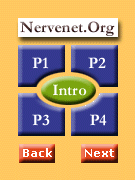




 |
 |
 |
 |
 |
|
|

|
|
||
|
RESEARCH PLAN |
|||
|
Principal Investigator/Program Director Williams, Robert W. |
|||
|
Mapping Brain Weight QTLs with RI Strains and F2
Crosses.
Over the past two years, Williams and colleagues have used three F2 intercrosses and additional RI strains to define several additional brain weight QTLs . The advantage of the F2 crosses is that QTLs with relatively small effects on brain weight can be mapped. One of these F2 crosses is between BALB/cJ, a strain with a very large brain, and CAST/Ei, a wild Asian mouse with a small brain. In this cross, brain weights of the F1 generation overlap those of the BALB/cJ parental strain. Although it appears that a heavy brain weight is inherited as a dominant trait, all of these F1 progeny were born to BALB/cJ mothers, and maternal nongenetic factors are probably important. The variance among F2 individuals is higher than that of the parental strains. This increase in variance is due to the segregation and assortment of QTLs that affect brain weight among F2 offspring. It is satisfying to move away from the phenomenology of brain weight and to describe variation in terms of individual gene loci. However, we still do not know what parts of the brain or what cell populations are most affected. We are taking two approaches to these questions. The first approach is to literally disassemble each brain into component parts and determine how the weights of these parts co-vary with the weight of the whole minus the weight of the part. Using this approach, we have succeeded in mapping four QTLs that have selective effects of the size of the cerebellum . The second approach is to proceed directly to stereological investigations of CNS nuclei and cell populations. This, of course, is the main goal of this program project. A library of brain tissue from particular crosses would be especially useful since investigators could map multiple QTLs and study the genetic basis of correlations among different CNS regions. This strategy would also greatly reduce the amount of effort put into genotyping. This is precisely why we have spent the past two years beginning the slow process of building a large library of sectioned mouse brains suitable for quantitative genetic analysis of CNS architecture. This is also the reason why we have initially opted to concentrate our efforts on well-characterized lines of RI strains. While RI strains do suffer from some inherent problems for QTL analysis, they have the very significant advantage of making studies of genetic correlation between interconnected parts of the CNS possible. Investigators can also then use the data we generate for RI sets to explore behavioral, developmental, and neuropharmacological correlates of differences in CNS structure and cellular demographics.
|
|||
|
NEXT TOPIC |
|||